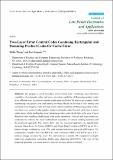Two-Layer Error Control Codes Combining Rectangular and Hamming Product Codes for Cache Error
Author(s)
Zhang, Meilin; Ampadu, Paul
DownloadZhang-2014-Two-layer error cont.pdf (990.4Kb)
PUBLISHER_CC
Publisher with Creative Commons License
Creative Commons Attribution
Terms of use
Metadata
Show full item recordAbstract
We propose a novel two-layer error control code, combining error detection capability of rectangular codes and error correction capability of Hamming product codes in an efficient way, in order to increase cache error resilience for many core systems, while maintaining low power, area and latency overhead. Based on the fact of low latency and overhead of rectangular codes and high error control capability of Hamming product codes, two-layer error control codes employ simple rectangular codes for each cache line to detect cache errors, while loading the extra Hamming product code checks bits in the case of error detection; thus enabling reliable large-scale cache operations. Analysis and experiments are conducted to evaluate the cache fault-tolerant capability of various existing solutions and the proposed approach. The results show that the proposed approach can significantly increase Mean-Error-To-Failure (METF) and Mean-Time-To-failure (MTTF) up to 2.8×, reduce storage overhead by over 57%, and increase instruction per-cycle (IPC) up to 7%, compared to complex four-way 4EC5ED; and it increases METF and MTTF up to 133×, reduces storage overhead by over 11%, and achieves a similar IPC compared to simple eight-way single-error correcting double-error detecting (SECDED). The cost of the proposed approach is no more than 4% external memory access overhead.
Date issued
2014-02Department
Massachusetts Institute of Technology. Department of Electrical Engineering and Computer ScienceJournal
Journal of Low Power Electronics and Applications
Publisher
MDPI AG
Citation
Zhang, Meilin, and Paul Ampadu. “Two-Layer Error Control Codes Combining Rectangular and Hamming Product Codes for Cache Error.” Journal of Low Power Electronics and Applications 4, no. 1 (February 27, 2014): 44–62.
Version: Final published version
ISSN
2079-9268